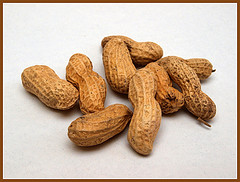
Classification:
 Domain: Eukarya
Domain: Eukarya
Kingdom: Plantae
Phylum: Magnoliophyta
Class: Magnoliopsida
Order: Fabales
Family: Leguminosae
Sub-family: Papilionaceae
Genus: Arachis
Species: hypogaea
 The
picture to the right is a cladistic phylogenetic tree that illustrates how the peanut works its way down the
various levels of classifictaion. Beginning with the domain, eukarya,
and ending with the species, hypogaea, this tree shows what
other organismal groups are near each of the peanuts classification
levels. Please click on the picture to see a larger, more legible
version.
The
picture to the right is a cladistic phylogenetic tree that illustrates how the peanut works its way down the
various levels of classifictaion. Beginning with the domain, eukarya,
and ending with the species, hypogaea, this tree shows what
other organismal groups are near each of the peanuts classification
levels. Please click on the picture to see a larger, more legible
version.
Domain Eukarya: The cells in a eukaryotic organism possess a true nucleus. The organelles are membrane bound and the organism has multiple linear chromosomes in its nucleus. Most eukaryotes, including Arachis hypogaea, are multicellular.
Kingdom Plantae: All land plants reproduce by way of an alternation of generations, meaning there is both a haploid and a diploid phase in their life cycles. Most plants are photosynthetic, meaning they create their own food. We'll talk more about the peanut's food production in nutrition.
Phylum Magnoliophyta: Also known as the
angiosperms, these are the flowering plants. This is the largest of
the plantae phyla. Magnoliophyta have leaves, stems, roots, vascular
tissue, flowers, and fruits.
is the largest of
the plantae phyla. Magnoliophyta have leaves, stems, roots, vascular
tissue, flowers, and fruits.
Class Magnoliopsida: This class is also known as the Dicotyledons. These dicots usually have two seed leaves.
Order Fabales: This order is one of the core dicots. Although it possesses 754 genera and more than 20,000 species, more than 95% of them belong to the Leguminosae family.
Family Leguminosae: This family is also known as Fabaceae. The third largest family of angiosperms, Leguminosae is only smaller than Asteraceae (sunflower family) and Orchidaceae (orchid family). Most legumes have root nodules that contain a symbiotic rhizobial bacteria (scroll down on link to "Nitrogen fixation") that converts atmospheric nitrogen (N2) into a more usable form for the plant, such as ammonia (NH3).
Sub-family Papilionaceae: This sub-family is also known as Faboideae. Members of this sub-family usually have pinnate, or feather-like, leaves, irregular flowers, lateral petals, and ten stamens. The stamens are the pollen producing reproductive organ.
Genus Arachis: This genus of plant has pods that ripen underground.
Species hypogaea: Hypogaea translates to 'under the earth' or 'crypt.' The part of the plant that most people recognize as the peanut, the seed, grows underground.
 The
picture to the left is a phylogenetic tree created based off of
genetic and chemical similarities among various angiosperms. The
closer two families are branched, the more similar they are to each
other. The family peanuts belong to, Leguminosae, is written in
yellow for easy recognition. Please click on the picture to see a
larger, more legible version.
The
picture to the left is a phylogenetic tree created based off of
genetic and chemical similarities among various angiosperms. The
closer two families are branched, the more similar they are to each
other. The family peanuts belong to, Leguminosae, is written in
yellow for easy recognition. Please click on the picture to see a
larger, more legible version.